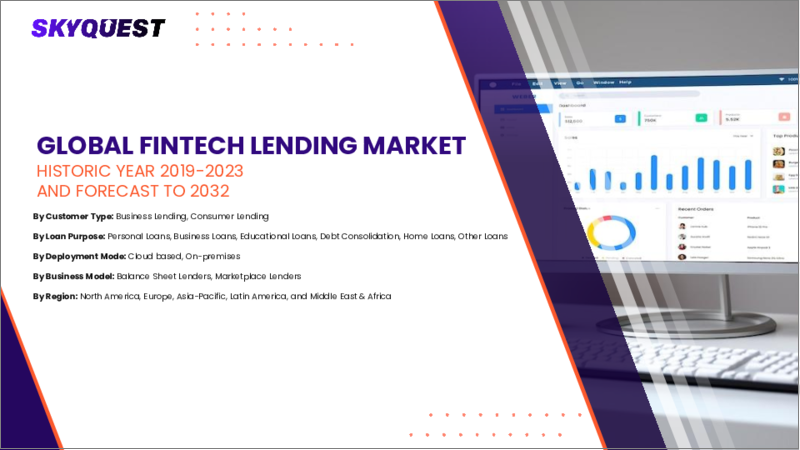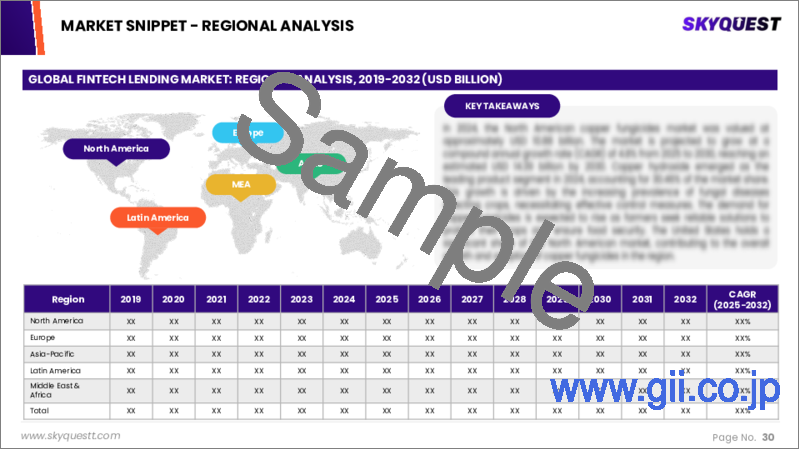|
|
市場調査レポート
商品コード
1653946
フィンテックレンディングの市場規模、シェア、成長分析:ローンタイプ別、返済方法別、テクノロジーの種類別、金利モデル別、配信チャネル別、地域別 - 産業予測 2025~2032年Fintech Lending Market Size, Share, and Growth Analysis, By Loan Type, By Repayment Method, By Technology Type, By Interest Model, By Delivery Channel, By Region - Industry Forecast 2025-2032 |
||||||
|
|||||||
| フィンテックレンディングの市場規模、シェア、成長分析:ローンタイプ別、返済方法別、テクノロジーの種類別、金利モデル別、配信チャネル別、地域別 - 産業予測 2025~2032年 |
|
出版日: 2025年02月10日
発行: SkyQuest
ページ情報: 英文 157 Pages
納期: 3~5営業日
|
全表示
- 概要
- 目次
フィンテックレンディングの世界市場規模は、2023年に9,100億1,000万米ドルと評価され、2024年の1兆1,593億5,000万米ドルから2032年には8兆458億3,000万米ドルに成長し、予測期間(2025年~2032年)のCAGRは27.4%で成長する見通しです。
フィンテックレンディング市場は、ローンやクレジットのデジタル金融サービスを包含し、過去10年間で大きな成長を遂げ、特に個人や企業の資金調達手段を再構築してきました。この分野は革新的な技術で繁栄しており、時間がかかりがちな従来の銀行業務に代わる、よりアクセスしやすく便利な手段を提供しています。フィンテック金融機関は、データ分析とAIを活用して信用力を評価し、迅速な資金調達ソリューションの魅力を高めています。主に、ピアツーピア(P2P)融資プラットフォームがリーダーとして台頭しており、仲介者を介さない個人間の直接取引を可能にしています。これにより、プロセスが合理化され、借り手の金利が向上する一方、投資家には魅力的なリターンがもたらされます。COVID-19の大流行は、フィンテックレンディングの採用を加速させ、迅速な金融支援を提供する上で重要な役割を果たすことを浮き彫りにしました。中央銀行も政府も、景気刺激策の資金配分にフィンテックレンダーが効率的であることを認めています。
目次
イントロダクション
- 調査の目的
- 調査範囲
- 定義
調査手法
- 情報調達
- 二次と一次データの方法
- 市場規模予測
- 市場の前提条件と制限
エグゼクティブサマリー
- 世界市場の見通し
- 供給と需要の動向分析
- セグメント別機会分析
市場力学と見通し
- 市場概要
- 市場規模
- 市場力学
- 促進要因と機会
- 抑制要因と課題
- ポーターの分析
主な市場の考察
- 重要成功要因
- 競合の程度
- 主な投資機会
- 市場エコシステム
- 市場の魅力指数(2024年)
- PESTEL分析
- マクロ経済指標
- バリューチェーン分析
- 価格分析
フィンテックレンディング市場規模:ローンタイプ別
- 市場概要
- 個人ローン
- 中小企業向けローン
- 住宅ローン
- 自動車ローン
- 学生ローン
フィンテックレンディング市場規模:返済方法別
- 市場概要
- 分割払いローン
- クレジットライン
- インボイスファイナンス
- マーチャントキャッシュアドバンス
フィンテックレンディング市場規模:テクノロジーの種類別
- 市場概要
- 人工知能(AI)と機械学習(ML)
- ブロックチェーン
- モバイルテクノロジー
- ビッグデータ分析
フィンテックレンディング市場規模:金利モデル別
- 市場概要
- 固定金利
- 変動金利
- 固定金利
- 複利金利
フィンテックレンディング市場規模:配信チャネル別
- 市場概要
- オンライン貸金業者
- 従来型の銀行
- 信用組合
- ピアツーピアレンダー
フィンテックレンディング市場規模
- 北米
- 米国
- カナダ
- 欧州
- ドイツ
- スペイン
- フランス
- 英国
- イタリア
- その他欧州地域
- アジア太平洋地域
- 中国
- インド
- 日本
- 韓国
- その他アジア太平洋地域
- ラテンアメリカ
- ブラジル
- その他ラテンアメリカ地域
- 中東・アフリカ
- GCC諸国
- 南アフリカ
- その他中東・アフリカ
競合情報
- 上位5社の比較
- 主要企業の市場ポジショニング(2024年)
- 主な市場企業が採用した戦略
- 最近の市場動向
- 企業の市場シェア分析(2024年)
- 主要企業の企業プロファイル
- 企業の詳細
- 製品ポートフォリオ分析
- 企業のセグメント別シェア分析
- 収益の前年比比較(2022~2024年)
主要企業プロファイル
- Affirm(United States)
- LendingClub(United States)
- LendingTree(United States)
- Sezzle(United States)
- Funding Circle(United Kingdom)
- Klarna(Sweden)
- Zilch(United Kingdom)
- SoFi Technologies(United States)
- Upstart Holdings(United States)
- Prosper Marketplace(United States)
- OnDeck Capital(United States)
- Enova International(United States)
- Avant(United States)
- Sunlight Financial(United States)
- PagSeguro Digital(Brazil)
- Qudian(China)
- LexinFintech Holdings(China)
- FinVolution Group(China)
- 360 DigiTech(China)
結論と提言
Global Fintech Lending Market size was valued at USD 910.01 billion in 2023 and is poised to grow from USD 1159.35 billion in 2024 to USD 8045.83 billion by 2032, growing at a CAGR of 27.4% during the forecast period (2025-2032).
The fintech lending market, encompassing digital financial services for loans and credit, has experienced significant growth over the past decade, particularly reshaping funding avenues for individuals and businesses. This sector thrives on innovation, offering a more accessible and convenient alternative to traditional banking methods, which are often time-consuming. Fintech lenders leverage data analytics and AI to evaluate creditworthiness, driving the appeal of quick financing solutions. Predominantly, peer-to-peer (P2P) lending platforms are emerging as leaders, enabling direct transactions between individuals without intermediaries, which streamlines the process and enhances interest rates for borrowers while providing attractive returns for investors. The COVID-19 pandemic accelerated fintech lending adoption, highlighting its critical role in delivering speedy financial assistance. Both central banks and governments recognize the efficiency of fintech lenders in distributing stimulus funds.
Top-down and bottom-up approaches were used to estimate and validate the size of the Global Fintech Lending market and to estimate the size of various other dependent submarkets. The research methodology used to estimate the market size includes the following details: The key players in the market were identified through secondary research, and their market shares in the respective regions were determined through primary and secondary research. This entire procedure includes the study of the annual and financial reports of the top market players and extensive interviews for key insights from industry leaders such as CEOs, VPs, directors, and marketing executives. All percentage shares split, and breakdowns were determined using secondary sources and verified through Primary sources. All possible parameters that affect the markets covered in this research study have been accounted for, viewed in extensive detail, verified through primary research, and analyzed to get the final quantitative and qualitative data.
Global Fintech Lending Market Segments Analysis
Global Fintech Lending Market is segmented by Loan Type, Repayment Method, Technology Type, Interest Model, Delivery Channel and region. Based on Loan Type, the market is segmented into Personal Loans, Small Business Loans, Mortgages, Auto Loans and Student Loans. Based on Repayment Method, the market is segmented into Installment Loans, Line of Credit, Invoice Financing and Merchant Cash Advances. Based on Technology Type, the market is segmented into Artificial Intelligence (AI) and Machine Learning (ML), Blockchain, Mobile Technology and Big Data Analytics. Based on Interest Model, the market is segmented into Fixed Interest Rates, Variable Interest Rates, Flat Interest Rates and Compounding Interest Rates. Based on Delivery Channel, the market is segmented into Online Lenders, Traditional Banks, Credit Unions and Peer-to-Peer Lenders. Based on region, the market is segmented into North America, Europe, Asia Pacific, Latin America and Middle East & Africa.
Driver of the Global Fintech Lending Market
The burgeoning Global Fintech Lending market is significantly propelled by the widespread adoption of the internet and smartphones, alongside advancements in digital technology. These fintech platforms have revolutionized access to financial services for both individuals and businesses, enabling them to apply for loans and receive approvals online with remarkable ease. Unlike traditional banks, fintech lending solutions boast accelerated processing times, primarily due to their efficient and user-friendly interfaces. As a result, consumers can manage their financial needs more conveniently, which further enhances the appeal of these innovative platforms in the competitive lending landscape.
Restraints in the Global Fintech Lending Market
The global fintech lending market faces significant constraints due to the diverse regulatory standards that vary across different jurisdictions. Navigating the complex web of compliance requirements can prove time-consuming and burdensome for fintech lenders, who may struggle to adhere to intricate regulations. Additionally, the inconsistencies in consumer protection laws and lending approval processes further complicate market dynamics. As these regulations continue to evolve, fintech lending companies may encounter substantial challenges in their day-to-day operations and in scaling their business. The resulting uncertainty can hinder growth strategies and impede their ability to adapt effectively in a competitive landscape.
Market Trends of the Global Fintech Lending Market
The Global Fintech Lending market is experiencing a significant trend toward the expansion of online and digital lending platforms, driven by their unparalleled convenience and accessibility. As consumers increasingly prioritize speed and efficiency in financial transactions, these platforms leverage advanced technologies such as data analytics to streamline the lending process, offering swift loan applications, approvals, and fund disbursement through user-friendly mobile apps and websites. This shift in consumer behavior towards digital financial solutions has bolstered the popularity of fintech lending across various demographics and geographies, positioning it as a crucial player in the evolving financial landscape and ensuring robust growth in the coming years.
Table of Contents
Introduction
- Objectives of the Study
- Scope of the Report
- Definitions
Research Methodology
- Information Procurement
- Secondary & Primary Data Methods
- Market Size Estimation
- Market Assumptions & Limitations
Executive Summary
- Global Market Outlook
- Supply & Demand Trend Analysis
- Segmental Opportunity Analysis
Market Dynamics & Outlook
- Market Overview
- Market Size
- Market Dynamics
- Drivers & Opportunities
- Restraints & Challenges
- Porters Analysis
- Competitive rivalry
- Threat of substitute
- Bargaining power of buyers
- Threat of new entrants
- Bargaining power of suppliers
Key Market Insights
- Key Success Factors
- Degree of Competition
- Top Investment Pockets
- Market Ecosystem
- Market Attractiveness Index, 2024
- PESTEL Analysis
- Macro-Economic Indicators
- Value Chain Analysis
- Pricing Analysis
Global Fintech Lending Market Size by Loan Type & CAGR (2025-2032)
- Market Overview
- Personal Loans
- Small Business Loans
- Mortgages
- Auto Loans
- Student Loans
Global Fintech Lending Market Size by Repayment Method & CAGR (2025-2032)
- Market Overview
- Installment Loans
- Line of Credit
- Invoice Financing
- Merchant Cash Advances
Global Fintech Lending Market Size by Technology Type & CAGR (2025-2032)
- Market Overview
- Artificial Intelligence (AI) and Machine Learning (ML)
- Blockchain
- Mobile Technology
- Big Data Analytics
Global Fintech Lending Market Size by Interest Model & CAGR (2025-2032)
- Market Overview
- Fixed Interest Rates
- Variable Interest Rates
- Flat Interest Rates
- Compounding Interest Rates
Global Fintech Lending Market Size by Delivery Channel & CAGR (2025-2032)
- Market Overview
- Online Lenders
- Traditional Banks
- Credit Unions
- Peer-to-Peer Lenders
Global Fintech Lending Market Size & CAGR (2025-2032)
- North America (Loan Type, Repayment Method, Technology Type, Interest Model, Delivery Channel)
- US
- Canada
- Europe (Loan Type, Repayment Method, Technology Type, Interest Model, Delivery Channel)
- Germany
- Spain
- France
- UK
- Italy
- Rest of Europe
- Asia Pacific (Loan Type, Repayment Method, Technology Type, Interest Model, Delivery Channel)
- China
- India
- Japan
- South Korea
- Rest of Asia-Pacific
- Latin America (Loan Type, Repayment Method, Technology Type, Interest Model, Delivery Channel)
- Brazil
- Rest of Latin America
- Middle East & Africa (Loan Type, Repayment Method, Technology Type, Interest Model, Delivery Channel)
- GCC Countries
- South Africa
- Rest of Middle East & Africa
Competitive Intelligence
- Top 5 Player Comparison
- Market Positioning of Key Players, 2024
- Strategies Adopted by Key Market Players
- Recent Developments in the Market
- Company Market Share Analysis, 2024
- Company Profiles of All Key Players
- Company Details
- Product Portfolio Analysis
- Company's Segmental Share Analysis
- Revenue Y-O-Y Comparison (2022-2024)
Key Company Profiles
- Affirm (United States)
- Company Overview
- Business Segment Overview
- Financial Updates
- Key Developments
- LendingClub (United States)
- Company Overview
- Business Segment Overview
- Financial Updates
- Key Developments
- LendingTree (United States)
- Company Overview
- Business Segment Overview
- Financial Updates
- Key Developments
- Sezzle (United States)
- Company Overview
- Business Segment Overview
- Financial Updates
- Key Developments
- Funding Circle (United Kingdom)
- Company Overview
- Business Segment Overview
- Financial Updates
- Key Developments
- Klarna (Sweden)
- Company Overview
- Business Segment Overview
- Financial Updates
- Key Developments
- Zilch (United Kingdom)
- Company Overview
- Business Segment Overview
- Financial Updates
- Key Developments
- SoFi Technologies (United States)
- Company Overview
- Business Segment Overview
- Financial Updates
- Key Developments
- Upstart Holdings (United States)
- Company Overview
- Business Segment Overview
- Financial Updates
- Key Developments
- Prosper Marketplace (United States)
- Company Overview
- Business Segment Overview
- Financial Updates
- Key Developments
- OnDeck Capital (United States)
- Company Overview
- Business Segment Overview
- Financial Updates
- Key Developments
- Enova International (United States)
- Company Overview
- Business Segment Overview
- Financial Updates
- Key Developments
- Avant (United States)
- Company Overview
- Business Segment Overview
- Financial Updates
- Key Developments
- Sunlight Financial (United States)
- Company Overview
- Business Segment Overview
- Financial Updates
- Key Developments
- PagSeguro Digital (Brazil)
- Company Overview
- Business Segment Overview
- Financial Updates
- Key Developments
- Qudian (China)
- Company Overview
- Business Segment Overview
- Financial Updates
- Key Developments
- LexinFintech Holdings (China)
- Company Overview
- Business Segment Overview
- Financial Updates
- Key Developments
- FinVolution Group (China)
- Company Overview
- Business Segment Overview
- Financial Updates
- Key Developments
- 360 DigiTech (China)
- Company Overview
- Business Segment Overview
- Financial Updates
- Key Developments





